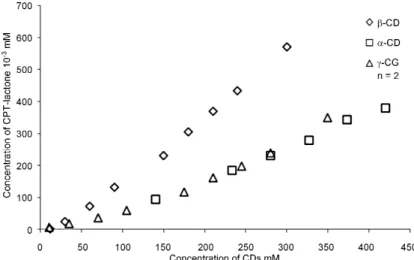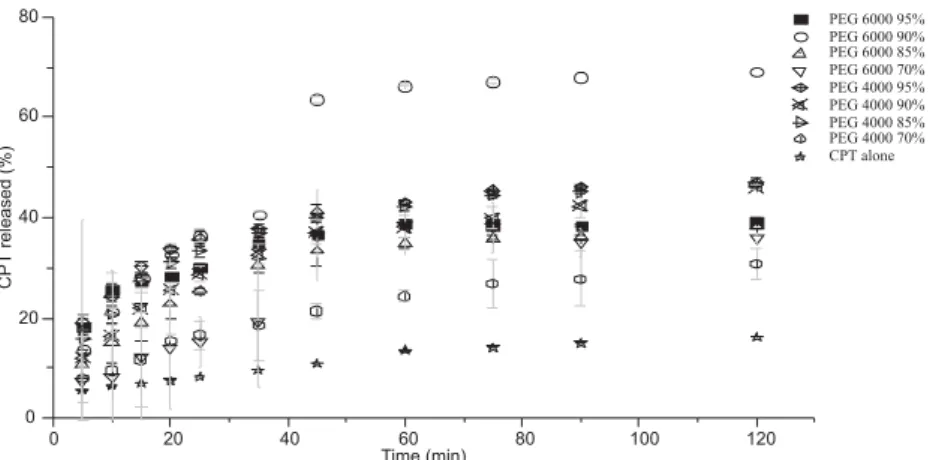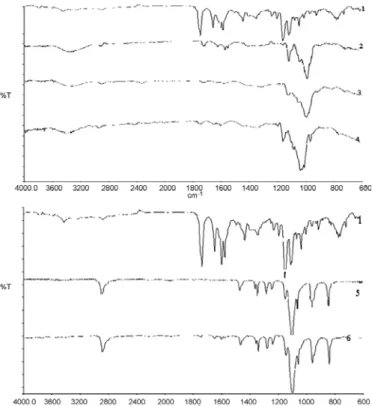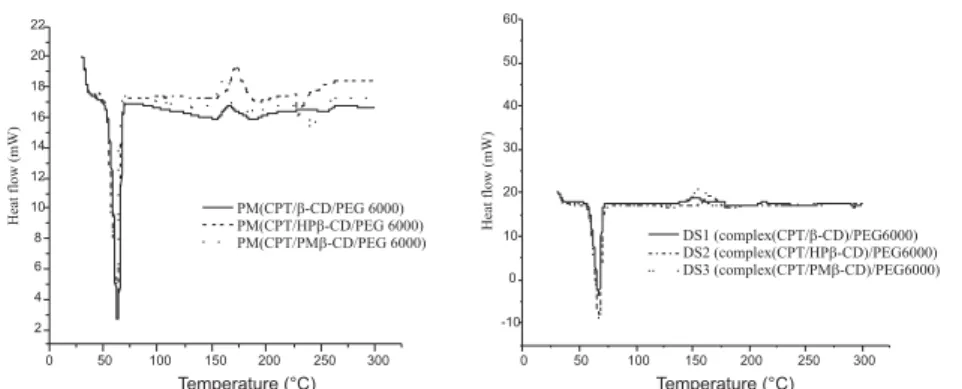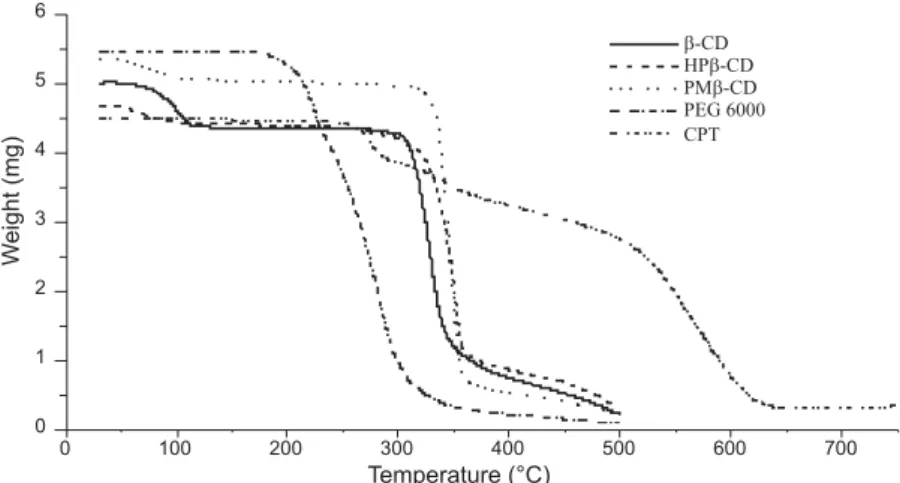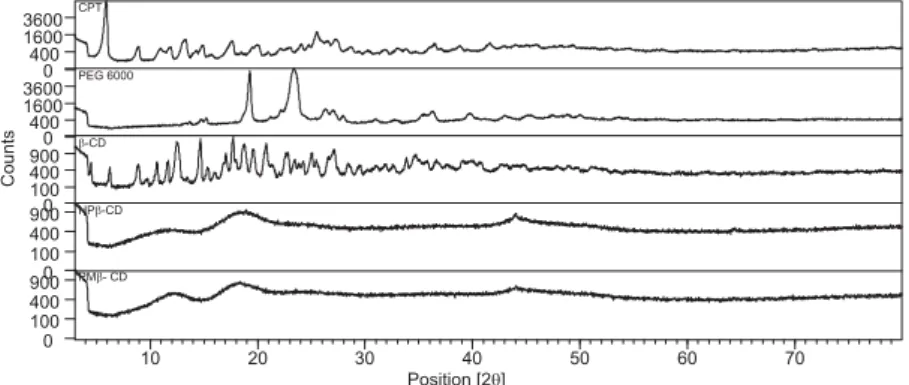Amorphous solid dispersion studies of camptothecin-cyclodextrin inclusion
complexes in PEG 6000
Article in Acta poloniae pharmaceutica · April 2015
CITATIONS 10
READS 342
6 authors, including:
Some of the authors of this publication are also working on these related projects: Drug encapsulation View project
Plant extracts in animal sperm cryopreservation View project Syed Fatmi
Maternity and Children Hospital, NAJRAN, SAUDIA ARABIA 8PUBLICATIONS 37CITATIONS SEE PROFILE Lamine Bournine Université de Béjaïa 8PUBLICATIONS 100CITATIONS SEE PROFILE Mokrane Iguer-ouada Université de Béjaïa 109PUBLICATIONS 1,427CITATIONS SEE PROFILE Lahiani-Skiba Malika Université de Rouen 62PUBLICATIONS 554CITATIONS SEE PROFILE
All content following this page was uploaded by Mohamed Skiba on 19 March 2015.
Camptothecin (CPT, Fig. 1) is an anti-cancer agent belonging to the family of the alkaloids, it is present in wood, bark and fruit of the Asian tree Camptotheca acuminata (1, 2). Camptothecin is known as DNA topoisomerase I inhibitor (3, 4) pre-senting a powerful anti-cancer activity against a wide spectrum of human malignancies, such as lung, prostate, breast, colon, stomach and ovarian carci-nomas (5). However, the full therapeutic potential of CPT is limited in relation to its poor solubility (6) inducing lack of activity, with a marked toxicity (7). This limited activity is mainly in relation to the pH
dependent behavior of the lactone ring (Fig. 1) (7, 8).
Several approaches are proposed to improve CPT or analogs solubility; especially the use of var-ious polymers such as: polyethylene glycol (PEG) (5, 9ñ11), poly(lactide-Co-glycolide), polycaprol-actone (12), o-carboxymethylchitosan (13) and cyclodextrins (CDs) (14ñ16).
Cyclodextrins are cyclic oligosaccharides com-posed of glucose units linked to each other by α (1→4) glycosidic bond. Three natural types of cyclodextrins are reported: α-cyclodextrin (α-CD),
AMORPHOUS SOLID DISPERSION STUDIES OF
CAMPTOTHECINñCYCLODEXTRIN INCLUSION COMPLEXES IN PEG 6000
SOFIANE FATMI1, 2, 3, LAMINE BOURNINE4, MOKRANE IGUER-OUADA3, MALIKA
LAHIANI-SKIBA1, FATIHA BOUCHAL2 and MOHAMED SKIBA1*
1Technology Pharmaceutical and Biopharmaceutics Laboratory, UFR Medicine and Pharmacy, Rouen
University, 22 Blvd. Gambetta, 76183, Rouen, France
2 Technology Pharmaceutical Laboratory, Department of Engineering Processes,
3Marine Ecosystems and Aquaculture Laboratory, 4 Plant Biotechnology and Ethnobotany Laboratory,
Faculty of Natural Sciences and Life, Abderrahmane-Mira University, Targua Ouzemmour road, 06000 Bejaia, Algeria
Abstract: The present work focused on the solubility enhancement of the poorly water-soluble anti-cancer agent camptothecin which, in its natural state, presents poor solubility inducing lack of activity with a marked toxicity. A new approach is adopted by using a ternary system including camptothecin (CPT) and cyclodextrins (CDs) dispersed in polyethylene glycol (PEG) 6000. Camptothecin solubility variations in the presence of α-CD, β-CD, γ-CD, hydroxypropyl-α-CD (HPα-CD), hydroxypropyl-β-CD (HPβ-CD), permethyl-β-CD (PMβ-CD) and sulfobutyl ether-β-CD (SBEβ-(PMβ-CD), were evaluated by Higuchi solubility experiments. In the second part, the most efficient camptothecin/β-CDs binary systems, mainly HPβ-CD and PMβ-CD, were dispersed in PEG 6000. In addition to a drug release and modeling evaluation, the CPT interactions with CDs and PEG 6000 to prepared the amorphous solid dispersion in the binary and ternary systems were investigated by Fourier trans-formed infrared spectroscopy (FT-IR), differential scanning calorimetry (DSC), thermogravimetric analyses (TGA) and X-ray powder diffraction (XRPD). The results showed that HPβ-CD and PMβ-CD were the most efficient for camptothecin solubilization with highest apparent equilibrium constants. Dissolution studies showed that percentage of CPT alone after two hour in 0.1 M HCl medium, did not exceed 16%, whereas under the same conditions, CPT/PMβ-CD complex reached 76%. When dispersing the binary systems CPT/β-CDs in PEG 6000, the velocity and the percentage of CPT release were considerably improved whatever the CD used, reaching the same value of 85%. The binary and ternary systems characterization demonstrated that CPT inclused into the CDs cavity, replacing the water molecules. Furthermore, a drug transition from crystalline to amorphous form was obtained when solid dispersion is realized. The present work demonstrated that ternary complexes are promising systems for CPT encapsulation, and offer opportunities to use non toxic and com-monly solubilizing carriers: βCD and PEG 6000 to improve bioavailability.
Keywords:camptothecin, cyclodextrins, kinetic model, PEG 6000, amorphous solid dispersion characteriza-tion, ternary complex
179 * Corresponding author: e-mail: mohamed.skiba@univ-rouen.fr
β-cyclodextrin (β-CD) and γ-cyclodextrin (γ-CD) composed of 6, 7 and 8 units of glucopyranoses (Fig. 2), respectively (17, 18). They result from the enzymatic degradation of the starch by cyclodex-trins glucosyl transferases (CGTases) (18). The glu-cose units are bonded together to form a truncated cone shaped molecule with a broadest end contain-ing secondary and tertiary hydroxyls, and a narrow-est end containing primary hydroxyls (19). As a consequence, the inner cavity of cyclodextrins is hydrophobic and the exterior hydrophilic (20). This fact is used to increase molecules aqueous solubility by inclusion complexes (21).
In the present work, solubility of camptothecin in the presence of various CDs: α-CD, β-CD, γ-CD, hydroxypropyl-α-CD (HPα-CD), hydroxypropyl-γ-CD (HPγ-CD), hydroxypropyl-β-CD (HPβ-CD), permethyl-β-CD (PMβ-CD) and sulfobutyl ether-β-CD (SBEβ-CD) was investigated and the equilibri-um constants (Kc) were determined. Inclusion com-plexes were prepared and dissolution profiles were studied.
A new approach was also investigated to enhance CPT solubility by a ternary system: com-plexes CPT/CD dispersed in PEG (Fig. 2). The later, is a water-soluble, nontoxic, non-antigenic, biocom-patible polymer that has been approved by the Food
and Drug Administration for human intravenous, oral, and dermal applications (22), its most common form is a linear or branched polyether ended with hydroxyl groups (23). In order to investigate the effect of PEG on both camptothecin and its corre-sponding inclusion complexes, dissolution profiles were realized. Finally, the nature of interaction in binary and ternary systems, were studied using dif-ferent methods: Fourier transformed infrared spec-troscopy (FT-IR), differential scanning calorimetry (DSC), thermogravimetric analyses (TGA) and X-ray powder diffraction (XRPD).
MATERIALS AND METHODS Materials
Drug
Camptothecin (M.w. 348.11 g/mol) was pur-chased from Shenzhen Boda Natural Product labo-ratory (P. R. China).
Cyclodextrins
β-CD was obtained from Roquette Frères (France) (1135 g/mol), α-CD (972 g/mol), γ-CD (1297 g/mol), hydroxypropyl-β-CD (HPβ-CD, 1488 g/mol), hydroxypropyl-α-CD (HPα-CD, 1285 g/mol) and hydroxypropyl-γ-CD (HPγ-CD, 1713
Figure 1. CPT structure (active and inactive form) (9)
g/mol) were provided by Wacker (Germany). Permethylated β-CD (PMβ-CD, 1330 g/mol) was received from Orsan (France). Sulfobutyl ether β-CD, SBE-CD (2163 g/mol) was purchased from Cydex, Inc. (USA).
Polyethylene glycol
PEG 4000 and 6000 were obtained from BASF (Germany).
All reagents were of analytical grade.
Methods
HPLC analyses
The analysis of lactone and carboxylate forms of CPT in solubility study, were performed using HPLC system which consisted of Jasco PU-980 pomp, Jasco AS-950 auto injector and Merck multi-channel photo Detector L 3000, equipped with C-18 analytical column. The mobile phase consisted of a mixture of a borate buffer and acetonitrile (65 : 35, v/v). Standard solution was prepared by dissolving CPT in a mixture of acetone / DMSO (95 : 5, v/v).
Solubility experiments and apparent equilibrium constant determination
The solubility measurement was carried out according to the method of Higuchi and Connors reported by Brewster and Loftsson (26). Excess of CPT was suspended in 5 mL pH 2.0 phosphate buffer solution (PBS pH 2) containing increasing concentrations of CDs : γ-CD (0ñ180 M), β-CD (0ñ16 mM), a-CD (0ñ150 mM), PMβ-CD (0ñ300 mM), SBEβ-CD (0ñ90 mM), HPγ-CD (0ñ350 M), HPβ-CD (0ñ467 mM) and HPa-CD (0ñ300 mM), all solutions were shaken at 37OC under a constant
agi-tation rate. Aliquots were withdrawn at the equilib-rium after one week. The aliquots were filtered through 0.45 µm membrane and quantified by HPLC. Each experiment was carried out in dupli-cate. The apparent binding constants were calculat-ed from the straight line portion of the phase solu-bility diagram according to Higuchi-Connors, given in equation (1):
Kc = slope/ So (1-slope) (Equation 1) where So = drug solubility without CDs.
Preparation of binary systems
Solid inclusion complexes prepared by solvent evaporation method
Cyclodextrins and CPT in a 1 : 1 molar ratio were dissolved in 50 mL of ethanol, the mixture was left under agitation for 1 h protected from light. After drying at 45OC during 1 h, the powder was
pre-served in a dessicator.
Solid dispersion (SD) CPT/ PEGs
Mixtures of CPT/ PEG 6000 or PEG 4000 at 5/95, 10/90, 15/85 and 30/70% (w/w) were dis-solved in ethanol by agitation. After drying at 45OC
during 1 h, the powder was preserved in a dessica-tor.
Preparation of ternary systems
Solid dispersion CPT complexes / PEG 6000 Nine parts of polyethylene glycol 6000 and one part of CPT in its complexes form were dissolved in ethanol by agitation. After drying at 45OC during 1
h, the powder was preserved in a dessicator.
Physical mixtures
Nine part of polyethylene glycol 6000 and one part of CPT in complexes form were mixed in a mortar until obtaining an apparent homogeneous powder. The latter was preserved in a dessicator.
Characterization of inclusion complexes and solid dispersions
Fourier transformed infrared spectroscopy (FT-IR) The FT-IR spectra were taken from dried sam-ples. An FT-IR machine from PerkinElmer equipped with an ATR was used in the frequency between 4000 cm-1and 700 cm-1.
Differential scanning calorimetry (DSC)
Thermal analysis was performed using a PerkinElmer differential scanning calorimeter (DSC-4), which was equipped with a compensated power system. All samples were weighed at around 5 mg and heated at a scanning rate of 10OC/min to a
temperature level between 30 and 350OC under a
nitrogen gas flow. Aluminum pans and lids were used for all samples.
Thermogravimetric analysis (TGA)
TGA was carried out using thermal analyzer (PerkinElmer, USA) with attached TG unit. The sample was heated under normal atmosphere at a rate of 10OC/min, and the loss of weight was
record-ed in temperature range 30 to 750OC for the pure
drug and from 30 to 650OC for other samples.
X-ray powder diffraction (XRPD)
X-ray diffractograms of CPT, carriers, binary and ternary systems were recorded using an X-ray diffractometer (XíPert Propan analytical, Nether-lands) using RTMS detector, generated at 40 kV and 30 mA and scanning rate of 2O/min over a 2θ range
Dissolution studies
Dissolution profiles of free CPT, inclusion complexes or SDs were evaluated. Briefly, 10 mg of free CPT or its equivalent of complexes or SDs were added to 900 mL of hydrochloric acid (0.1 M) at 37 ± 0.5OC, the rotation speed paddle was fixed at 75
rpm. The amount of dissolved CPT was evaluated on Beckman DU 640 B spectrophotometer at 286 nm. Each analysis was repeated in triplicate.
Drug release kinetics
In order to establish the mathematical model of CPT release from different preparations, the experi-mental data were fitted to commonly kinetic models (like zero order, first order, Higuchi, and Korsmeyer-Peppas) reported by Tapan et al. (27), where:
Zero-order model: F = K0t, where F represents the
fraction of drug released in time t and K0 is the
apparent release rate constant or zero-order release constant.
First-order model: ln (1ñF) = K1stt, where F
repre-sents the fraction of drug released in time t and K1st
is the first-order release constant.
Higuchi model: F = KHt1/2, where F represents the
fraction of drug released in time t and KH is the
Higuchi dissolution constant.
Korsmeyer-Peppas model: F = KPtn, where F
repre-sents the fraction of drug released in time t, KPis the
rate constant and n is the diffusional exponent, it indicates the drug release mechanism (28ñ30).
RESULTS AND DISCUSSION Solubility experiment
The solubility of CPT according to different CDs concentrations is shown in Figures 3ñ5. The CPT apparent solubility increased with CDs
concen-tration. When using natural or modified β-CDs, CPT solubility increased linearly, it exhibits typical AL curves corresponding to equivalent molar ratio between CD and CPT as reported by Kang et al. (15) and Foulon et al. (31). The apparent equilibrium constant (Kc), is calculated using an equation pro-posed by Higuchi and Conners:
Kc = So / intercept (1-slope) (Equation 2) where So = drug solubility without CDs.
The modified and natural α- and γ-CDs showed AP curves. As described by Brewster (26), it is corresponding to CPT/CDs 1 : 2, 1 : 3 molar ratios. The Kc in this case is calculated using the lin-ear portion of the curves. The maximal apparent CPT solubility and equilibrium constant are report-ed in Table 1.
Among the natural CDs, αCD induced the greatest increase in CPT solubility with approxi-mately sixteen folds compared to CPT alone. βCD and γCD, in contrast, increased two- and twelve folds CPT solubility, at their water solubility limit, respectively. These results suggest that αCD is the most effective solubilizing agent for CPT. This is in relation to its higher intrinsic solubility compared to βCD, with a more adequate size cavity compared to γCD. However, when working at low CD concentra-tions, 1.5% (w/v) for βCD and 2.5% (w/v) for αCD and γCD, respectively, Kang et al. (15) found that βCD is more effective in solubilizing CPT. According to Brewster (26), the solubility study should be realized at CDs water solubility limit.
Among the three modified HP-CDs (HPα, HPβ and HPγ), HP-β-CD solubilized CPT to the greatest extent. Around water solubility limit of each HP-CDs (HPα, HPβ and HPγ), camptothecin solubility was increased by factor of 47, 70 and 43, respectively, when compared to CPT alone. It has been shown previously that HP cyclodextrins
Table 1. Solubility and equilibrium constants (Kc) for camptothecin complexes calculated from the slope of the best-fit line of the phase solubility.
CDs CPT max (10-3mM) So mM slope Smax/So Kc (M-1)
βCD 16 mM 1.84E+01 8.15Eñ03 1.19Eñ03 2.26E+00 1.46E+02
αCD 150 mM 1.32E+02 8.15Eñ03 4.63Eñ04 1.62E+01 5.69E+01
γCD 180 mM 1.03E+02 8.15Eñ03 5.07Eñ04 1.27E+01 6.22E+01
HPβCD 300 mM 5.71E+02 8.15Eñ03 1.97Eñ03 7.01E+01 2.43E+02
HPαCD 420.6 mM 3.80E+02 8.15Eñ03 1.04Eñ03 4.66E+01 1.28E+02
HPγCD 350 mM 3.50E+02 8.15Eñ03 5.58Eñ04 4.29E+01 6.85E+01
SBEβCD 90 mM 2.32E+02 8.15Eñ03 2.30Eñ03 2.85E+01 2.83E+02
Figure 3. Solubility diagrams of camptothecin in the presence of natural CDs
Figure 4. Solubility diagrams of camptothecin in the presence of HPCDs
improved solubility by the presence of hydroxy-propyl groups (19). These results suggest also that β-CD cavity size is more adequate to CPT.
At 90 mM of SBE-β-CD, camptothecin solu-bility was increased by factor of 28 compared to the value obtained with CPT alone.
Among CDs tested in the present work, the most efficient is PM-β-CD in improving camp-tothecin solubility which was increased by 261 folds when compared to CPT alone. This could be attrib-uted to the presence of methyl groups, which not only disrupt hydrogen bonding, but also enlarge the whole cavity (14).
The equilibrium constants (Table 1) were in agreement with the values described in the litera-ture concerning drug-cyclodextrin complexation (32, 33). It can also be observed that the greatest value of Kc was obtained by complexation with β-CDs (natural and modified) compared to αCDs and γCDs, indicating that the bonding strength between camptothecin and this type of CDs is more important, meaning that their size cavities are more adequate to load CPT. Similar equilibri-um constants were obtained by Kang et al. (15) and Saetern et al. (8).
From these results, HP-β-CD and PM-β-CD, the two best CPT solubilizers, were selected for fur-ther experiments, considering β-CD as reference.
Selection of adequate polymer and concentration
The percentages of CPT released from each SD according to mass percentage and type of PEG are presented in Figure 6. Kinetic release of CPT from each SDs was realized in triplicate.
Improvement of the drug dissolution in all cases is probably attributed to the hydrophilic nature
of the polymers (26, 31), with wettability increasing (34) and amorphization of the drug by the carriers in solid dispersions (35). It clearly appeared that PEG 6000 was the best polymer improving CPT dissolu-tion. Moreover, 90% of PEG (w/w) seems to be the most efficient with the less variation on the basis of relative standard deviation (36). For this reason, PEG 6000 at 90% (w/w) was selected for further experiments.
Characterization of inclusion complexes and solid dispersions
FT-IR analysis
Figures 7 and 8 represent the FT-IR spectra of CPT binary and ternary systems.
FT-IR spectroscopy analysis showed that there were weak interactions between the drug and the carrier used in complexation or solid dispersion. This is clearly observed with contracting and disap-pearance of the drug peaks around: 1750 cm-1
corre-sponding to C=O stretching vibration of lactone ring, 1655 cm-1 corresponding to C=O stretching
vibration of ketone groups and 1490 cm-1
correspon-ding to vibrations of phenyl rings (37ñ40). The physical mixture FT-IR spectra showed simultane-ously the presence of characteristic peaks of CPT, PEG 6000 and CDs, suggesting that there is no inter-action. On the basis of these results, it can be retained that whole drug or at least some of drug groups are incorporated into cyclodextrin cavities and also suggest that there is intermolecular interac-tion between CPT and PEG molecules.
Differential scanning calorimetry (DSC)
Differential scanning calorimetry thermograms of pure drug and carriers, CPT binary systems and
Figure 7. FT-IR spectra of: 1) CPT, 2) (CPT/β-CD) complex, 3) (CPT/HPβ-CD) complex, (CPT/PMβ-CD) complex, 5) PEG 6000 and 6) (CPT/PEG 6000) SD
Figure 8. FT-IR spectra of: (7 SD1 ((CPT/β-CD)/PEG 6000), (8 SD2 ((CPT/HPβ-CD)/PEG 6000), (9 SD3 ((CPT/PMβ-CD)/PEG 6000), (10 PM1 ((CPT/β-CD)/PEG 6000), (11 PM2 ((CPT/HPβ-CD)/PEG 6000) and (12 PM3 ((CPT/β-ñCD)/PEG 6000)
CPT ternary systems are shown in Figures 9ñ11. Melting endotherms of CPT which are around 265 and 273OC (indicating crystalline nature of the drug
(41)) disappeared totally in thermograms correspon-ding to CPT/CDs complexes, CPT/PEG 6000 SD (SDo) and CPT complexes/PEG 6000. In contrast,
they remained present in PM thermograms. This may indicate inclusion of CPT within the CD cavity replacing water. In case of SDs, only endothermic peak of PEG at 67OC is observed, the disappearance
of CPT melting endotherms indicated the absence of crystalline drug replaced by its amorphous form (28,
Figure 9. Differential scanning calorimetry thermograms of pure materials
Figure 10. Differential scanning calorimetry thermograms of CPT binary systems, CPT complexes (left) and SD (right)
40ñ42). The DSC thermograms indicated the forma-tion of inclusion complex between CDs and CPT and also indicated a significant dispersion of CPT or its corresponding complexes in PEG 6000. Similar findings have been reported for CPT complexation with HP-β-CD and β-CD by Cirpanli et al. (32).
Thermogravimetric analysis (TGA)
It is reported that through the formation of host-guest inclusion complexes, the thermal stabili-ties of CDs and guests should be affected (43). The thermogravimetic graphs of pure drug, carriers, complexes and SDs are shown in Figures 12 and 13. Drug showed 84% weight loss, started around 145OC and stabilized around 639OC. This is probably
related to the decomposition of CPT structure induced by the transition from solid to liquid phase. PEG 6000 showed 98% weight loss, from 166 to 478OC indicating the decomposition of the polymer.
Cyclodextrins presented three stages of weight loss (Fig. 12), where less than 120OC the lost weight
indi-cates the loss of water molecules included in CDs cavities. The weight loss percentages of each CD are presented in Table 2.
Previous studies have reported the presence of water molecules, depending on the relative humidi-ty in CDs (44, 45). Consequently, weight loss in the range 270ñ500OC was related to CD structure
decomposition due to the transition from solid to liq-uid phase (44). Relatively slow weight decrease
Table 2. Weight loss percentages of CDs, complexes and SDs calculated from dehydration step of TGA.
Analyzed products Dehydration step
Temperature range (OC) Weight loss (%)
βCD 30 119 12.60 HP-βCD 30 108 5.35 PMβCD 30 108 5.42 CPT/ βCD complex (IC 1) 30 102 4.98 CPT/ HP-βCD complex (IC 2) 30 102 4.50 CPT/ PM-βCD complex (IC 3) 30 102 4.80 SD (CPT/ βCD complex) / PEG (SD1) 30 107 1.57 SD (CPT/ HP-βCD complex)/PEG (SD2) 30 107 0.99 SD (CPT/ PM-βCD complex)/PEG (SD3) 30 107 1.40
Table 3. Drug release kinetic data obtained from fitting the drug release experimental data to different mathematical model of drug release.
IC 1 IC 2 IC 3 SD 1 SD 2 SD 3 SDo
Zero order model
Ko 0.0023 0.0028 0.0027 0.0022 0.0024 0.0027 0.0051
R2 0.83 0.65 0.90 0.63 0.55 0.80 0.79
First order model
K1 0.0035 0.0044 0.0070 0.0080 0.0090 0.0100 0.0100 R2 0.87 0.69 0.96 0.75 0.67 0.90 0.83 Higuchi model KH 0.031 0.041 0.037 0.033 0.037 0.039 0.072 R2 0.94 0.80 0.98 0.79 0.71 0.91 0.90 Korsmeyer-Peppas model KP 0.20 0.17 0.40 0.54 0.53 0.50 0.14 R2 0.90 0.75 0.96 0.78 0.69 0.89 0.87 n 0.09 0.12 0.06 0.047 0.052 0.055 0.18
around 500OC indicated the thermal degradation of
ìcharsî, the residues formed during the second stage of CDs decomposition (44).
For the both binary and ternary systems, the thermogram patterns were different from the pure materials and since the ranges of degradation of both drug and carrier change, this difference indicates the
occurrence of interactions between the drug and car-riers and in consequence, the formation of new sys-tems. It is also found in the present study that the dehydration patterns of binary and ternary systems (Table 2) were different from the thermal behavior of pure CDs. The percentages of water evaporation decreased when complexes are formed indicating
Figure 12. Thermogravimetic graphs of pure CPT and carriers.
substitution of water molecules by CPT, and this decrease was more important when complexes are dispersed in PEG 6000. This fact could be explained by the substitution of water molecules by CPT in one hand, and by the solid dispersion method itself that eliminates most water molecules, in other hand. Surprisingly, the thermogram patterns of PM (CPT/CDs/PEG 6000), did not show any evapora-tion of water molecules, probably in relaevapora-tion to mass dominance of PEG 6000 and to none homogenous systems. This can also be supported by the similari-ty of thermogram patterns of SDs and pure PEG 6000.
X-ray powder diffraction (XRPD)
XRPD of raw materials, binary and ternary systems are shown in Figures 14 and 15. The CPT diffractogram revealed a crystalline compound, showing a very strong diffraction peaks at 2θ of 6O,
9O, 11O, 12O, 17.6Oand 25O. Nevertheless, the XRD
pattern of CPT complexes and solid dispersions (binary and ternary systems) showed that some
char-acteristic peaks of pure CPT were absent and others appeared with a markedly reduced intensity. This suggests the formation of CD inclusion complexes by intermolecular interaction as reported earlier (46, 47). This also demonstrates that the CPT crystalline state dispersed in PEG 6000 had changed to an amorphous form, with improvement of drug disso-lution as demonstrated below. This phenomenon had been reported for etoricoxib when it is dispersed in PEG (34).
Dissolution studies
The in vitro dissolution profiles of CPT, vari-ous ICs, SDo (binary systems) and varivari-ous SDs of inclusion complexes in PEG 6000 (ternary systems) are shown in Figure 16.
Binary system
The fastest dissolution rate and the most important dissolved percentage of camptothecin were obtained with CPT/ PM-βCD complex, 76% of the drug was dissolved within 120 min. It was also
Figure 14. XRPD diffraction of raw materials
observed that solid dispersion was more effective in enhancing CPT dissolution (70%) than HP-βCD and βCD complexes. This is probably related to drug crystallinity decrease and the wettability improve-ment related to PEG 6000 as demonstrated for prog-esterone and indomethacin SDs (42, 48). The pres-ent results demonstrated that solid dispersion of CPT in PEG 6000 is a valuable concurrent to CPT / CDs complexes.
Ternary system
All SDs samples showed dissolution improve-ment when compared to CPT alone. This is mainly attributed in one part to the formation of inclusion complex, in the second part to wettability increasing by PEG 6000 and to the amorphous state of CPT in SDs preparation. It is also observed that all solid dis-persions revealed more CPT dissolution when
com-pared to their respective complexes. This is proba-bly due to the effect of PEG 6000 and to the solid dispersion preparation. (35, 42, 48). Surprisingly, in all SDs preparations, whatever the IC used, 85% of dissolved CPT is reached, a recommendable value for tablet drug release (36), which indicates that there is a synergic effect between CDs and PEG 6000 without regards to the CD substitutions.
In order to establish the mathematical model-ing of CPT release, the experimental data were fitted to kinetic models: zero order, first order, Higuchi, and Korsmeyer-Peppas models (49ñ51).The values for the diffusional exponent (n), correlation coeffi-cient (R2) and release rate coefficient (k) obtained
are summarized in Table 3. The best correlation coefficients (R2) were obtained with Higuchi model,
as it was reported by Costa in his review (52). Higuchi describes drug release as a diffusion
Figure 16. In vitro percentage of CPT released from binary (A) and ternary (B) systems in 0.1 M HCl. Triplicates for each sample except CPT (n = 3)
)
*
CPT dissolved (%) CPT dissolved (%)process based in the Fickís law, square root time dependent. When modelization was done by Korsmeyer-Peppas model, the value of the exponent n for all formulations was below 0.43, which was further indicative of the drug releases following Fickian diffusion control mechanism (50, 53).
CONCLUSION
The purpose of the present paper was the improvement of camptothecin solubility and its dis-solution rate. These aims were achieved either by forming CPT/CDs complexes, by solid dispersion of 10% of camptothecin in PEG 6000 (w/w) or by for-mation of ternary systems (CPT/CDs/PEG 6000). HPβ-CD and PMβ-CD appeared to be the most effi-cient in solubilizing CPT, these two CDs in addition to β-CD enhanced the velocity and the percentage of dissolved CPT, achieving 76% after 120 min, partic-ularly when using PMβ-CD. Moreover, CPT release from solid dispersion (CPT/PEG 6000, 10/90% (w/w)) reached a significant percentage (70%). However, the ternary systems, whatever the CPT complex used, appeared to be the most potent in enhancing the dissolution percentages and velocities. Physicochemical characterization (FT-IR, DSC, TGA and XRPD) demonstrated that camptothecin is incorporated into cyclodextrin cavity, replacing the water molecules. CPT 10% (w/w) or its complexes equivalent are well dispersed in PEG 6000, with appearance of amorphous state of the drug.
The synergic effect of complexation by cyclodextrins and solid dispersion in PEG 6000 con-duced to a CPT release following Fickian diffusion reaching 85% in a gastric medium. This main result, offers promising perspectives of new CPT formula-tion tablets combining the use of non expensive, non toxic and commonly solubilizing carriers: β-CD and PEG 6000.
REFERENCES
1. Paranjpe P.V., Chen Y., Kholodovych V., Welsh W., Stein S., Sinko P.J.: J. Control. Release 100, 275 (2004).
2. Hsiang Y.H., Hertzberg R., Hecht S., Liu L.F.: J. Biol. Chem. 260, 14873 (1985).
3. Li Q.Y., Zu Y.G., Shi R.Z., Yao L.P.: Curr. Med. Chem. 13, 2021 (2006).
4. Thiele C., Auerbach D., Jung G., Wenz G.: J. Incl. Phenom. Macrocycl. Chem. 69,303 (2011).
5. Xie C., Li X., Luo X., Yang Y., Cui W., Zou J., Zhou S.: Int. J. Pharm. 391, 55 (2010).
6. Berrada M., Serreqi A., Dabbarh F., Owusu A., Gupta A., Lehnert S.: Biomaterials 26, 2115 (2005).
7. Lorence A., Nessler C.L.: Phytochemistry 65, 2735 (2004).
8. Saetern A.M., Nguyen N.B., Bauer-Brandl A., Brandl M.: Int. J. Pharm. 284,61 (2004). 9. Cheng J., Khin K.T., Jensen G.S., Liu A., Davis
M.E.: Bioconjugate Chem. 14,1007 (2003). 10. Watanabe M., Kawano K., Yokoyama M.,
Opanasopit P., Okano T., Maitani Y.: Int. J. Pharm. 308,183 (2006).
11. Greenwald R.B., Pendri A., Conover C.D., Lee C., Choe Y.H., Gilbert C., Martinez A. et al.: Bioorg. Med. Chem. 6, 551 (1998).
12. Cýrpanli Y., Allard E., Passirani C., Bilensoy E., Lemaire L., Calýþ S., Benoit J.P.: Int. J. Pharm. 403, 201 (2011).
13. Aiping Z., Jianhong L., Wenhui Y.: Carbohyd. Polym. 63, 89 (2006).
14. Jiang Y., Sha X., Zhang W., Fang X.: Int. J. Pharm. 397, 116 (2010).
15. Kang J., Kumar V., Yang D., Chowdhury P.R., Hohl R.J.: Eur. J. Pharm. Sci. 15, 163 (2002). 16. Cirpanli Y., Bilensoy E., Dogan A.L., Calis S.:
J. Control. Release 148, e21 (2010).
17. Bhaskara-Amrit U.R., Agrawal P.B., Warmoeskerken M.C.G.: Autex Res. J. 11, 94 (2011).
18. Katagery A., Sheikh M.: Int. Res. J. Pharm. 3, 52 (2012).
19. Lala R., Thorat A., Gargote C.: IJRAP 2, 1520 (2011).
20. Loftsson T., Duchene D.: Int. J. Pharm.. 329, 1 (2007).
21. Chadha R., Kapoor V., Thankur D., Kaur R., Arora P., Jain D.V.S.: J. Sci. Ind. Res. India 67, 185 (2008).
22. Cheng T.L., Chuang K.H., Chen B.M., Roffler S.R.: Bioconjugate Chem. 23, 881 (2011). 23. Banerjee S.S., Aher N., Patil R., Khandare J.: J.
Drug Deliv. 10, 1155 (2012).
24. Dodziuk H.: Cyclodextrins and Their Complexes, p. 2, Wiley-VCH, Weinheim 2006. 25. Li W., Zhan P., De Clercq E., Lou H., Liu X.:
Prog. Polym. Sci. 38, 421 (2012).
26. Brewster M.E., Loftsson T.: Adv. Drug Deliv. Rev. 59, 645 (2007).
27. Giri T.K., Kumar K., Alexander A., Ajazuddin, Badwaik H., Tripathi D.K.: Bulletin of Faculty of Pharmacy, Cairo University 50, 147 (2012). 28. Hasnain M.S., Nayak A.K.: Chemistry:
Bulgarian Journal of Science Education 21, 118 (2012).
29. Dash S., Murthy P.N., Nath L., Chowdhury P.: Acta Pol. Pharm. Drug Res. 67, 217 (2010). 30. Barzegar-Jalali M., Adibkia K., Valizadeh H.,
Shadbad M.R., Nokhodchi A., Omidi Y., Mohammadi G. et al.: J. Pharm. Pharm. Sci. 11, 167 (2008).
31. Foulon C., Tedou J., Lamerie T.Q., Vaccher C., Bonte J.P., Goossens J.F.: Tetrahedron Asymmetry 20, 2482 (2009).
32. Cirpanli Y., Bilensoy E., Lale Doan A., Cali∫ S.: Eur. J. Pharm. Biopharm. 73, 82 (2009). 33. Bricout H., Hapiot F., Ponchel A., Tilloy S.,
Monflier E.: Sustainability 1, 924 (2009). 34. Suhagia B.N., Patel H.M., Shah S.A., Rathod I.,
Parmar V.K. Acta Pharm. 56, 285 (2006). 35. Almeida H.M., Cabral Marques H.M.: J. Incl.
Phenom. Macrocycl. Chem. 70, 397(2011). 36. The United States Pharmacopeia 30, NF 25, p.
1010, Rockville, Maryland 2007.
37. Swaminathan S., Pastero L., Serpe L., Trotta F., Vavia P., Aquilano D., Trotta M. et al.: Eur. J. Pharm. Biopharm. 74, 193 (2010).
38. Dong L., Li Y., Hou W.G., Liu S.J.: J. Solid State Chem. 183, 1811 (2010).
39. Guijin L., Hongdi W., Yanbin J.: Ind. Eng. Chem. Res. 52, 15049 (2013).
40. Bai L., Song L.X., Wang M., Zhu L.H.: Chinese J. Chem. Phys. 23, 117 (2010).
41. Thakral N.K., Ray A.R., Bar-Shalom D., Eriksson A.H., Majumdar D.K.: AAPS PharmSciTech 13, 59 (2012).
42. Wulff M., AldÈn M.: Eur. J. Pharm. Sci. 8, 269 (1999).
43. Dutet J., Lahiani-Skiba M., Didier L., Jezequel S., Bounoure F., Barbot C., Arnaud P., Skiba M.: J. Incl. Phenom. Macrocycl. Chem. 10, 203 (2007).
44. Zafid M.S., Afidah A.R., Abdullah J.M., Shariza A.R.: Biomed. Res. India 23, 513 (2012).
45. Moriwaki C., Costa G.L., Ferracini C.N., Moraes F.F., Zanin G.M., Pineda E.A.G., Matioli G.: Braz. J. Chem. Eng. 25, 225 (2008). 46. Shaikh J., Ankola D.D., Beniwal V., Singh D., Kumar M.N.: Eur. J. Pharm. Sci. 37, 223 (2009).
47. Yallapu M.M., Jaggi M., Chauhan S.C.: Colloids Surface B 79, 113 (2010).
48. Lahiani-Skiba M., Barbot C., Bounoure F., Joudieh S., Skiba M.: Drug Dev. Ind. Pharm. 32, 1043 (2006).
49. Takahashi A.I., Veiga F.J.B, Ferraz H.G.: Int. J. Pharm. Sci. Rev. Res. 12, 1 (2012).
50. Muthu M.S., Singh S.: Curr. Drug Deliv. 6, 62 (2009).
51. Dredan J., Antal I., Racz I.: Int. J. Pharm. 145, 61 (1996).
52. Costa P., Sousa Lobo J.M. : Eur. J. Pharm. Sci. 13, 123 (2001).
53. Zhang X., Zhang X., Wu Z., Gao X., Cheng C., Wang Z., Li C.: Acta Biomater. 7, 585 (2011).
Received: 10. 12. 2013
View publication stats View publication stats


